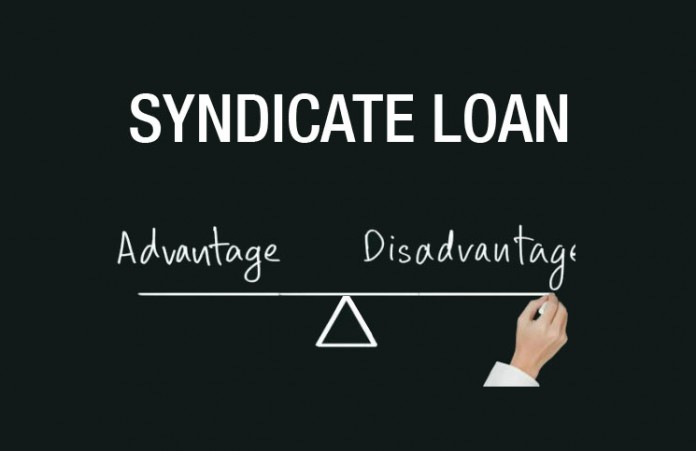In this blog post, Isha Singh, a student pursuing her LL.B (5h year) Hons. from Rajiv Gandhi National University of Law, Patiala, Punjab and a Diploma in Entrepreneurship Administration and Business Laws from NUJS, Kolkata, details the advantages and the disadvantages of a syndicate loan.
Syndicate Loans – Meaning & Concept
A syndicated loan is a credit lent out by a syndicate or a group of lenders and is structured or arranged by one or several commercial or investment banks called arrangers.[1] These are also amalgamated instruments that combine features of relationship lending and publicly-traded debt.
These are also amalgamated instruments that combine features of relationship lending and publicly-traded debt.
They permit risk-sharing among the potential financial institutions without disclosure and market burdening that bind issuers undergo. These credits account for an impressive international financing, roughly one-third, including bond, commercial paper and equity issues.[2]
Elements of a Syndicate Loan
Precisely, in the case of a Syndicate Loan, there is a lead banker or underwriter of the loan, known as the arranger, the agent or the lead lender. This lender may put up a relatively bigger share of the loan or may perform tasks such as dispersal of cash flows among other syndicate members and other administrative duties.
The prime motive of syndicate lending is to distribute the jeopardy of a borrower’s default across multiple lenders like banks, institutional investors such as hedge funds or pension funds. The reason why such an arrangement of syndicate lending is brought in place is that syndicate lending is larger than standard bank loans, and in those circumstances, even one borrower-default could devastate a single creditor. Syndicated loans are also used to fund large corporate takeovers with primarily debt funding.
These loans could be made on a best-effort basis, viz, if sufficient investors couldn’t be found, then the amount received by the Borrower would be lower than originally expected. These loans can also be split into dual trenches for banks who fund standard revolvers and institutional investors that fund fixed-rate term loans.[3]

Advantages of Syndicate Loans
Syndicate Loans offer an amalgamation of effort and the opportunity to create new banking contacts. Lenders also prefer syndications, as Fidler and Neymeyer explained, that “…they permit the lenders to make more loans while limiting individual exposures and spreading their risk within portfolios more widely…” They further explained,“…Moreover, administration of the loan is extremely efficient, with the agent managing much of the process on behalf of the participants…”[4]
Syndicated loans are centred on the creation of an alliance of smaller banking institutions that, because of this union, can meet the credit needs of the borrower. This creation is accelerated by appointment of an agent who manages the account. The arranger will then assemble a group of banks or a syndicate, after consultations with the borrower, with each bank lending portions of the required amount. The loan is sanctioned six to eight weeks after the mandate is awarded, and post the signing; the borrower is free to raise funds. The borrowers are required to pay upfront fees and some annual charges to the participating banks along with interest accruing from the initial drawing date. Along with giving the flexibility of choice and variety to the borrower, they also enable him to raise the loan cheaply than through a series of bilateral loans.[5]
Other Advantages
Also, economists and syndicate executives contend that there are other, less obvious advantages to going with a syndicated loan. These benefits include:
- Syndicated loan facilitates competition for business by insinuating other banks to supply market information to a business in hopes of gaining recognition.
- Borrowers enjoy flexibility in structure and pricing, such that they have a variety of options in structuring their syndicate loans, including multi-currency options, risk management techniques, and prepayment rights without penalty.
- Syndicated facilities bring to the businesses the best prices in aggregate and spare the companies their time and effort that could have gone waste in individual dealing with each bank.
- Syndicate Lending also increases feedback in the sense how the banks are willing to share viewpoints on contemporary issues about the business that they are otherwise unwilling to share with the borrowing business.
- They also clear visibility in the open market for the borrower. Bunn remarked that rating agencies viewed a multi-year syndicate lending as a much stronger support than several bilateral one-year credit arrangements.[6]
Disadvantages of A Syndicate Loans
- Negotiating with one bank can take several days, which is a time-consuming process.
- Managing multiple ban relationships is an ardent task and requires investment both regarding money and time.
LawSikho has created a telegram group for exchanging legal knowledge, referrals and various opportunities. You can click on this link and join:
https://t.me/joinchat/J_
References:
[1] https://www.lcdcomps.com/d/pdf/LoanMarketguide.pdf
[2] http://www.bis.org/publ/qtrpdf/r_qt0412g.pdf
[3] http://www.investopedia.com/terms/s/syndicatedloan.asp
[4] http://www.referenceforbusiness.com/small/Sm-Z/Syndicated-Loans.html
[5] http://www.referenceforbusiness.com/small/Sm-Z/Syndicated-Loans.html
[6] http://www.referenceforbusiness.com/small/Sm-Z/Syndicated-Loans.html











